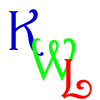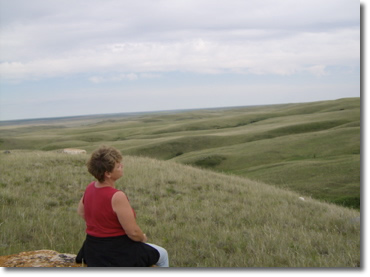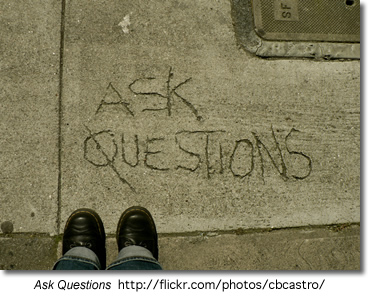Preparing to Use Information

The ability to effectively find, use and share information necessitates taking the time to determine what is known about a topic, acquire background knowledge, ask good questions and process information using graphic organizers and mind mapping programs.
This section of the problem-solving or research process covers the following:
- Activating prior knowledge
- Obtaining background information and knowledge by reading, viewing, listening and talking
- Collecting and documenting a wide variety of sources by using print and online tools
- Getting a general overview of topic
- Narrowing and finding focus
What I know - what I need to learn.
Students’ prior knowledge is activated when they are asked
- What they already Know
Students set goals specifying
- What they Want to Learn
After reading and research students discuss and comment on
- What they have Learned
Students use a KWL chart to note their thinking in each of the categories.
Example KWL Chart
Obtaining Background Knowledge
Reading, Listening, Talking, Viewing: Getting the Big Picture
 Obtaining background information is a stage that is often neglected in the research process. Students have a great deal of difficulty formulating a solid research question without sufficient knowledge about a topic. This stage of the inquiry process encourages students to become experts on their topic by reading, viewing, listening and talking to people about their topic. Allowing and encouraging sufficient time in this stage of the research process will enable students to narrow and focus on one particular aspect of their topic.
Obtaining background information is a stage that is often neglected in the research process. Students have a great deal of difficulty formulating a solid research question without sufficient knowledge about a topic. This stage of the inquiry process encourages students to become experts on their topic by reading, viewing, listening and talking to people about their topic. Allowing and encouraging sufficient time in this stage of the research process will enable students to narrow and focus on one particular aspect of their topic.
The activities in this stage of the process include collecting resources, examining bibliographies, creating working bibliographies that can be referred to later and reading, viewing, listening and talking to obtain a general overview of the topic. At this time the researcher is looking for key words, dates, people and events that will allow for other connections within the research. Student should read, look for major features and aspects of their topic and write them down.
Students can begin to get an overview of their topic by using general sources such as their textbooks and encyclopedias.
As students become more knowledgeable about their topics they will find it is easier to be focused and to generate good questions that will allow them to delve into further, meaningful research.
Documenting, Organizing and categorizing information:
During this time students should be keeping track of the resources that they have found. There are excellent online citation tools that allow them to document all bibliographic data as they go along and social bookmarking tools are an excellent way to collect, organize, evaluate and share web sites as they are found.
Students can use a social bookmarking tool such as delicious to collect, annotate and save resources that they find on the web on even on the online databases. These bookmarks can be accessed from any computer, from home or school.
The Overview: Encyclopedias and Textbooks
Obtaining an Overview: Using an Encyclopedia and the Textbook
Encyclopedia are excellent tools for gaining a general understanding about a topic. They provide a broader context of the research and in general terms explain what is known about the topic. Classroom textbooks are also very good sources for general information. Especially useful in many textbooks are the bibliographies that can be used to obtain further information.
understanding about a topic. They provide a broader context of the research and in general terms explain what is known about the topic. Classroom textbooks are also very good sources for general information. Especially useful in many textbooks are the bibliographies that can be used to obtain further information.
Three Useful Encyclopedias:
- The Encyclopedia Britannica is freely available to Saskatchewan schools and libraries and offers access to 3 encyclopedias:
- Encyclopedia Britannica for high school students
- Compton's Encyclopedia for middle years Students
- Britannica Elementary for elementary students
*these encyclopedia can only be accessed from within the school building.
- The Canadian Encyclopedia: great Canadian information
- Wikipedia: excellent source for current information especially with regards to technology and pop culture.
For more information on the differences and some of the issues with these encyclopedia read the post from Classroom Tech Tips
And... be sure to check out the student made video, What about Wikipedia, from Springfield High School in Philadelphia.
Finding a Focus
 Once a student has selected a topic and done substantial background reading they should be able to focus on one specific issue related to the topic. It should be a manageable aspect that is not too big nor too small.
Once a student has selected a topic and done substantial background reading they should be able to focus on one specific issue related to the topic. It should be a manageable aspect that is not too big nor too small.
If the focus is too specific than they may not find sufficient resources and if it is too large they may find themselves overwhelmed with information and not able to deal with the topic effectively.
It should be an important problem or a controversy within the topic itself. This does not mean that student should only choose major societal controversies to research but they should reflect on the issues within the field in which they are interested. For example, snow boarding… any type of musical genre… horse care and maintenance…
Controversial issues produce provocative essays, videos, blog postings, and podcasts because they are usually widely written about and they provide an opportunity to test conflicting interpretations, perspectives and values.
Online Citation Tools
Collecting and Documenting Resources
Students should be keeping track of the resources that they find during this stage of their research. If they do this as they research it will save a great deal of time and even frustration as they near the end of the research process.
There are a number of tools that students can use to keep track of the resources they find:
A generic working bibliography(.doc)
Free Online Citation Generators:
Citation Machine,is an interactive web tool designed to assist high school, college, and university students, their teachers, and independent researchers in their effort to respect other people's intellectual properties.
Ottobib, books only.... entering the ISBN provides instant citations in MLA, APA, and Chicago/Turabian styles
NoodleBib Express, Individual citations in MLA or APA format. Full range of citation types.![]()
BibMe, is a free online tool that allows you to create a works cited page or a reference page. You can save your bibliographies and print them.
Social Bookmarking
Social Bookmarking is a web-based service to share Internet bookmarks. The Social bookmarking sites are a popular way to store, classify, share and search links through the practice of tagging techniques on the Internet. (Wikipedia) When you save a bookmark on a Social Bookmarking site you can access the bookmarks anywhere and at anytime. You are not restricted to the favourites or bookmarks on a specific machine.
7 Things you should know about Social Bookmarking from Educause
"7 Things You Should Know About... Social Bookmarking" addresses a community—or social—approach to identifying and organizing information on the Web.
This video from Common Craft illustrates the major concepts involved with Social Bookmarking:
Examples:
- Donna's full set of delicious bookmarks
- Links tagged informationliteracy
There are several Social Bookmarking Services:
Tutorials, videos and step-by-step instructions:
This 2 1/2 minut screencast will show you how to get started using the social bookmarking tool delicious.
David Warlick has prepared two handouts which provide step-by-step instructions on how to create and use delicious bookmarks.
Get started using Delicious with the 'cheat sheet'.
Use Delicious for Social Bookmarking - an excellent set of tips to help you use delicious effectively.
Using Social Bookmarking in the Classroom
All Together Now: Social bookmarking offers a new way to store and share Web sites By Donna DesRoches -- School Library Journal, 1/1/2007
This article illustrates some ways that Social Bookmarking can be used with students.
Assessment
Bookmarking and Social Bookmarking Rubric - this rubric is based on Bloom's Revised Taxonomy.
Tagging
Tagging is an important concept in when using the read/write web. A tag is a (relevant) keyword or term associated with or assigned to a piece of information (like picture, article, or video clip), thus describing the item and enabling keyword-based classification of information it is applied to. (Wikipedia, Tag) Tagging is used to categorize bookmarks, photographs and blog posts more effectively enabling the sharing of online content.
For example: You can also share the bookmarks that you have collected by the URL. You can share all your bookmarks or you can share those that have been assigned a specific tag.
Why Tag
Asking Good Questions
 Questions may be the most powerful technology we have ever created" says Jamie McKenzie, author of Beyond Technology: Questioning, Research and the Information Literate School.
Questions may be the most powerful technology we have ever created" says Jamie McKenzie, author of Beyond Technology: Questioning, Research and the Information Literate School.
In an information and technology rich world it is easy for students to cut and paste the information they find for their fact-based assignments and projects. High School teacher-librarian, Joyce Valenza asks, with basic information so easy to access, shouldn't we now focus our students attention on questions that will challenge them to use information meaningfully - to think, analyze, evaluate and invent?"
Before students can start to ask good questions they need to see it modeled by their teachers. Tips for Teachers: Asking Good Questions, provides some questioning strategies that provoking high-level thinking. Jamie Mackenzie's Questioning Toolkit describes the many different types of questions that can be introduced as early as kindergarten to enable students to have powerful questioning technologies and techniques with them as they arrive in high school.
San Bonito High School's What I Want to Find Out: Questions, describes the difference between 'thin' and 'thick' questions and provides examples of how to turn a thin question into a fat one.
Creating Essential Questions outlines the key components of essential questions
Not All Questions are Created Equal
In his presentation handout, Designing Research Projects that Kids (and Teachers) Love, Doug Johnson outlines four levels of questions.
Questioning Flow (pdf) - a series of questions for middle and high school students to use when reading a selected passage.
Good Questions
The following examples of questions addressing each level are based on Doug Johnson's Good Questions hand-out from his presentation handout, Designing Research Projects that Kids (and Teachers) Love
Level One Question
My research is about a broad topic. I can complete the assignment by using a general reference source such as an encyclopedia.
Example: My research is about the causes of the genocide in Rwanda.
Level Two Question
My research answers a question that helps me narrow the focus of my search. The question may mean that I need to go to various sources to gather enough information to get a reliable answer. The conclusion of the research will ask me to give a supported answer to the question.
Example: Why was Romeo Dallaire unable to inform the world about the genocide in Rwanda?
Level Three Question
My research answers a question of personal relevance. To answer this question I may need to consult not just secondary sources such as magazines, newspapers, books or the Internet, but use primary sources of information such as original surveys, interviews, or source documents.
Example: How did the atrocities of the Rwanda genocide affect Constable xxxx, of North Battleford, during and after his time as a member of the Canadian Peacekeeping forces in Rwanda?
Level Four Question
My research answers a personal question about the topic, and contains information that may be of use to decision-makers as they make policy or distribute funds. The result of my research is a well-supported conclusion that contains a call for action on the part of an organization or government body. There will be a plan to distribute this information.
Example: The Genocide Convention defines genocide as "acts committed with intent to destroy, in whole or in part, a national, ethical, racial or religious group". Since the genocide in Rwanda ethic killings have taken place in Darfur in the Sudan. How might curricular and extra-curricular activities be utilized to motive students at NBCHS to lobby governments to take action and protect global citizens against such evil?
Graphic Organizers
Students who use concept maps in their search process were more likely to make metagcognitive judgments that lead to successful searching. (Carol Gordon)
 Graphic organizers are important tools to help students see how key ideas connect with each other and to organize data into categories.
Graphic organizers are important tools to help students see how key ideas connect with each other and to organize data into categories.
A graphic organizer or mindmap is usually a one-page
form with blank areas for the student to fill in with related ideas and information. Some organizers are very specific; others can be used with many topics. Some of the organizers allow for the information to be written or drawn, allowing students in all grade to use them.
Miguel MGuhlin noted in a blog post how graphic organizers can be used in all stages of finding using and sharing information.
In the preparing phase of the problem-solving or research process graphic organizers can be used to:
|
plan out the problem-solving or research process |
Chain of events Map |
|
idenify prolbem causes and interrelationships between them |
Fishbone Mapping |
| show interactions between events | Cycle |
| explore a topic and identify main ideas and details | Spider Map |
| to identify a problem and consider multiple solutions and possible results |
Problem/Solutio |
Teaching Tip: Jim Burke on using graphic organizers
Get more graphic organizers from EdHelper.com
Technology-based tools for graphic organizers and mind-mapping:
There are many computer tools that allow students to create concept and mind maps. Inspiration and Kidspiration are two of the better known tools. As well, there is a growing number of free open-source and web-based tools available. These tools run on your web browser therefore there is no need to download any additional software.
A very simple tool, ReadWriteThink Webbing Tool l, is perfect to engage younger students (grades 3 - 5) in the mind-mapping and webbing process.
Bubbl.us is a simple and free web application that lets you brainstorm online.
 Gliffy is an online, collaborative mindmapping tool that is simple to use. Features such as copy,paste and undo are all a part of this advanced web application.
Gliffy is an online, collaborative mindmapping tool that is simple to use. Features such as copy,paste and undo are all a part of this advanced web application.
Mindomo is also a free web-base mind mapping tool offering the capabilities of desktop mind mapping software in a Web browser - with no complex software to install or maintain. It's also a whole lot of fun to use!
All of these tools allow you to save your work online or to your desktop, share and work collaboratively on a document with others, and post your images to blogs or wikis.
Concept Maps
Concept maps differ from mindmaps in that they have a specific set of criteria which are used to link concepts. They are more rigid in their structure than free flowing mindmaps but are excellent tools for students to see how the information they are collecting links together. Concept maps are graphical tools for organizing and representing knowledge. They include concepts, usually enclosed in circles or boxes of some type, and relationships between concepts indicated by a connecting line linking two concepts. Words on the line, referred to as linking words or linking phrases, specify the relationship between the two concepts. (The Theory Underlying Concept Maps and How to Construct Them )
The attached document (doc), Skill: The Process of Concept Mapping, outlines the steps in creating a concept map for a Native Studies 30 assignment. The following free desktop programs are useful tools for meeting the concept mapping skill of the Saskatchewan Social Science curriculum objectives.
Freemind allows you to create a mapped image with links to a folding outline.
CMap creates structured linking concept maps.
More about concept maps:
An Introduction to Concept Maps:
- Tips on Making Your Own Concept Maps.
- Kinds of Concept Maps.
- Concept Map Bank.
Concept Maps go to School "We would like to use tools and a methodology that helps children construct knowledge," Tarte said. "Concept maps was the best tool that we found."
Concept Map Wiki - explanation, definitions, types of concept maps, application and reference links - a great resource for everything about concept maps.
Research Planners
Steps to Learning Success: A Research Planner Form
Hands-Up Research Planner (download from Flickr)
Clip useful information.
You can add clippings of text, images and links from web pages to your Google Notebook without ever leaving your browser window.
Organize your notes.
You can create multiple notebooks, divide them into sections, and drag-and-drop your notes to stay organized.
Get access from anywhere.
You can access your Google Notebooks from any computer by using your Google Accounts login.
Publish your notebook.
You can share your Google Notebook with the world by making it public.
You will need to have a Google Account to set up your google notebook. See this screencast to learn how to create your account.
Zotero - this Firefox add-on is perfect for students and professionals who need to keep track of a heavy load of research sites. The add-on stores PDFs, files, images, links and records in any language; automatically saves citations; offers a note taking autosave feature and more. The best part? It all fits neatly in your Firefox browser without getting in the way.
need to keep track of a heavy load of research sites. The add-on stores PDFs, files, images, links and records in any language; automatically saves citations; offers a note taking autosave feature and more. The best part? It all fits neatly in your Firefox browser without getting in the way.
Start Pages
Using Personalized Start Pages for your browser's home page is a tidy and efficient solution to keeping all your favorite and frequently visited resources on the Web on one handy and customizable page. From: Set Up Your Personalized Start Page with Netvibes, Pageflakes or Protopage
Other tools to be Organized
Remember the Milk - manage tasks
Organizing with Start Pages
Start Pages
Your Own Personal Web Page in Moments! Fun with Widgets!
Using Personalized Start Pages for your browser's home page is a tidy and efficient solution for keeping all your favourite and frequently visited resources on the Web on one handy and customizable page. Read more at Set Up Your Personalized Start Page with Netvibes, Pageflakes or Protopage.
Start Pages
NetVibes
Pageflakes
Protopage
View Donna's Protopage
